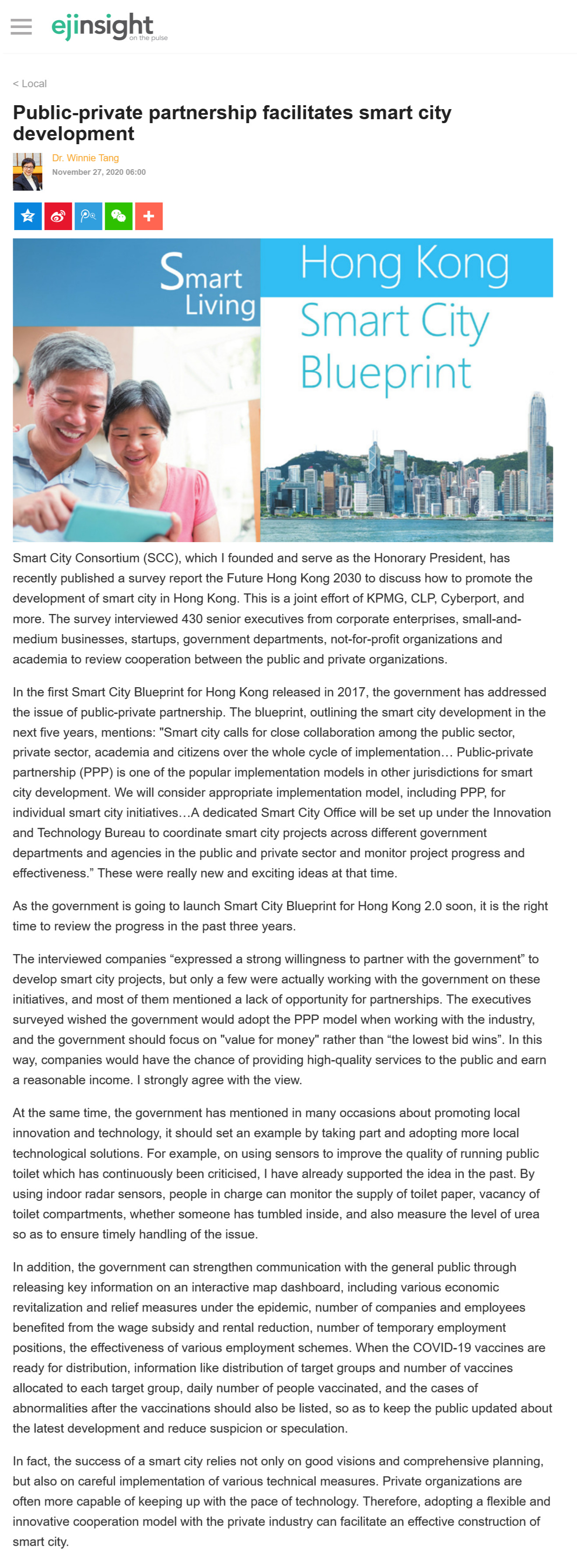網上版請按此

Public-private partnership facilitates smart city development
Smart City Consortium (SCC), which I founded and serve as the Honorary President, has recently published a survey report the Future Hong Kong 2030 to discuss how to promote the development of smart city in Hong Kong. This is a joint effort of KPMG, CLP, Cyberport, and more. The survey interviewed 430 senior executives from corporate enterprises, small-and-medium businesses, startups, government departments, not-for-profit organizations and academia to review cooperation between the public and private organizations.
In the first Smart City Blueprint for Hong Kong released in 2017, the government has addressed the issue of public-private partnership. The blueprint, outlining the smart city development in the next five years, mentions: "Smart city calls for close collaboration among the public sector, private sector, academia and citizens over the whole cycle of implementation... Public-private partnership (PPP) is one of the popular implementation models in other jurisdictions for smart city development. We will consider appropriate implementation model, including PPP, for individual smart city initiatives...A dedicated Smart City Office will be set up under the Innovation and Technology Bureau to coordinate smart city projects across different government departments and agencies in the public and private sector and monitor project progress and effectiveness." These were really new and exciting ideas at that time.
As the government is going to launch Smart City Blueprint for Hong Kong 2.0 soon, it is the right time to review the progress in the past three years.
The interviewed companies "expressed a strong willingness to partner with the government" to develop smart city projects, but only a few were actually working with the government on these initiatives, and most of them mentioned a lack of opportunity for partnerships. The executives surveyed wished the government would adopt the PPP model when working with the industry, and the government should focus on "value for money" rather than "the lowest bid wins". In this way, companies would have the chance of providing high-quality services to the public and earn a reasonable income. I strongly agree with the view.
At the same time, the government has mentioned in many occasions about promoting local innovation and technology, it should set an example by taking part and adopting more local technological solutions. For example, on using sensors to improve the quality of running public toilet which has continuously been criticised, I have already supported the idea in the past. By using indoor radar sensors, people in charge can monitor the supply of toilet paper, vacancy of toilet compartments, whether someone has tumbled inside, and also measure the level of urea so as to ensure timely handling of the issue.
In addition, the government can strengthen communication with the general public through releasing key information on an interactive map dashboard, including various economic revitalization and relief measures under the epidemic, number of companies and employees benefited from the wage subsidy and rental reduction, number of temporary employment positions, the effectiveness of various employment schemes. When the COVID-19 vaccines are ready for distribution, information like distribution of target groups and number of vaccines allocated to each target group, daily number of people vaccinated, and the cases of abnormalities after the vaccinations should also be listed, so as to keep the public updated about the latest development and reduce suspicion or speculation.
In fact, the success of a smart city relies not only on good visions and comprehensive planning, but also on careful implementation of various technical measures. Private organizations are often more capable of keeping up with the pace of technology. Therefore, adopting a flexible and innovative cooperation model with the private industry can facilitate an effective construction of smart city.
Dr. Winnie Tang
Adjunct Professor, Department of Geography, Faculty of Social Sciences and Faculty of Architecture, The University of Hong Kong